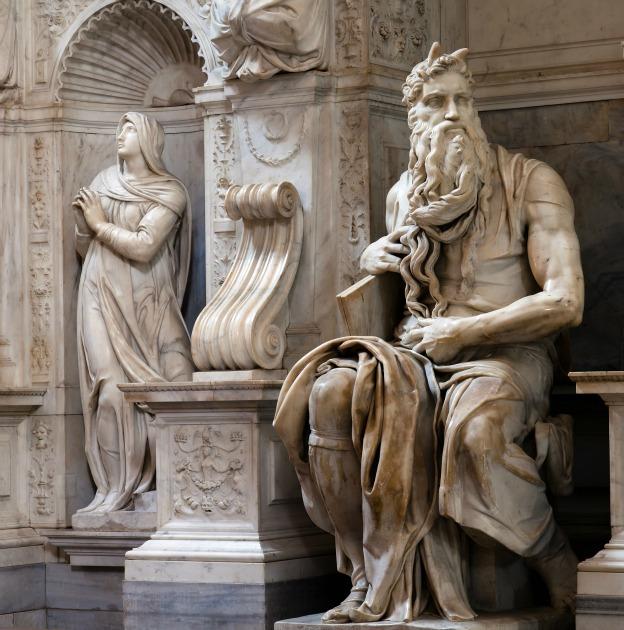Right in the heart of Monti, one of Rome’s most beautiful neighborhoods, roughly halfway along Via Cavour, is a little-known church not many tourists bother to visit. Which is unfortunate, since the Chiesa di San Pietro in Vincoli houses one of Michelangelo’s great masterpieces, a prime example of the artist’s incomparable skills as a sculptor: the statue of Moses.
The colossal marble statue, measuring 2.35 meters, was to be part of the funerary monument that pope Julius II commissioned to Michelangelo in 1505. The tomb was not completed until 1545, 32 years after the death of the pope – who, in fact, rests in St. Peter’s Basilica.
The initial design by Michelangelo was massive, featuring more than 40 statues. Moses would have been placed on a tier almost 4 meters high; in the final design, it sits in the center of the bottom tier.
Inspired by works by Raphael and Donatello, the statue depicts a seated Moses, holding the Tablets of the Law under his right arm; “and with the other holds his long glossy beard, the hairs, so difficult to render in sculpture, being so soft and downy that it seems as if the iron chisel must have become a brush,” describes Giorgio Vasari in his “Life of Michelangelo”.
Moses is depicted in the moment following the delivery of the Commandments on Mount Sinai, when he finds the Israelites intent on worshiping a golden calf. He looks irate and about to get up. His anger is well rendered by the swollen veins and tense muscles that seem to bring life to the marble.
The two horns on Moses’ head are thought to be due to an incorrect translation of a passage from the Book of Exodus, where Moses is described as having two rays on his forehead, as he came down from Mount Sinai, after speaking with God. The Jewish "karan" - "shining" or "emitting rays" - may have been confused with "keren" - "horns" in the Latin Vulgate translation.
Because of disagreements between Michelangelo and the Pope, who had become so absorbed with the reconstruction of St. Peter’s Basilica he had set aside his plans for the funerary monument, the work, which was originally destined to St. Peter's Basilica, was placed in San Pietro in Vincoli.
Art critics maintain that Moses is one of Michelangelo’s most beloved works. According to legend, when he completed the statue, pleased with the realism achieved, Michelangelo hit it and ordered it to speak.











